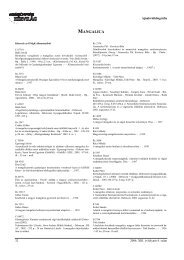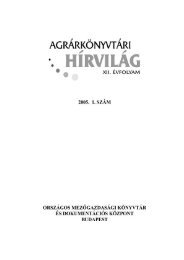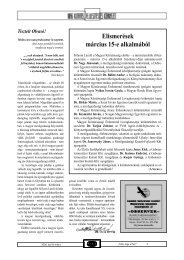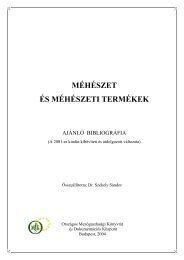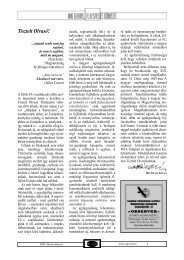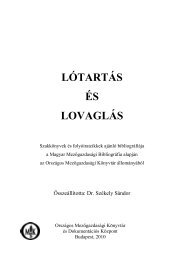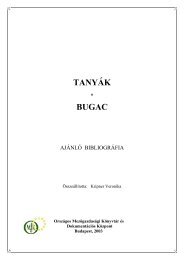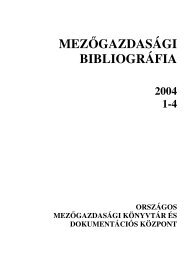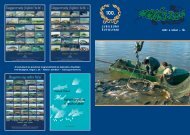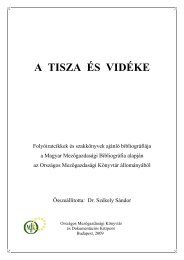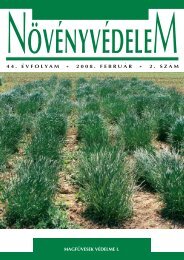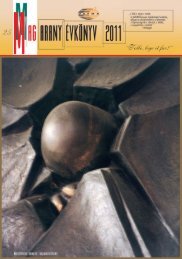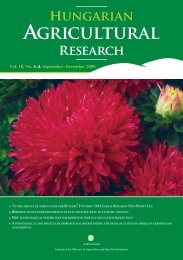45. ÃVFOLYAM * 2009. JÃNIUS * 6. SZÃM A KÃRIS VÃDELME
45. ÃVFOLYAM * 2009. JÃNIUS * 6. SZÃM A KÃRIS VÃDELME
45. ÃVFOLYAM * 2009. JÃNIUS * 6. SZÃM A KÃRIS VÃDELME
Create successful ePaper yourself
Turn your PDF publications into a flip-book with our unique Google optimized e-Paper software.
290 NÖVÉNYVÉDELEM 45 (6), 2009<br />
resznyelégy hím és nôstény egyedeinek csapdázhatósága<br />
között mindenképpen különbség<br />
van, amit a kétmintás t-próba is igazolt.<br />
Köszönetnyilvánítás<br />
Köszönettel tartozom Antal Tibornak és<br />
Horváth Róbertnek a horvátzsidányi meggyes<br />
tulajdonosainak és a peresznyei meggyes kezelôinek,<br />
dr. Borovics Attilának, a bajti csemetekert<br />
vezetôjének, hogy helyet és lehetôséget<br />
adtak ültetvényeikben vizsgálataim elvégzésére.<br />
IRODALOM<br />
AliNiazee, M. T. and L. E. Long (1995): Biology and<br />
control of the cherry fruit flies: A worldwide<br />
perspective. Proceedings of the International Cherry<br />
Fruit Fly Symposium held on March 3, 1995 at<br />
The Dalles, Oregon, U.S.A.<br />
Balás G. és Sáringer Gy. (1984): Kertészeti kártevôk. Akadémiai<br />
Kiadó, Budapest, 753–757.<br />
Boller, E. F. and G. L. Bush (1974): Evidence for genetic<br />
variation in populations of the european cherry fruit<br />
fly, Rhagoletis cerasi (Diptera: Tephritidae) based<br />
on physiological parameters and hybridization<br />
experiments. Ent. exp. appl., 17: 279–293.<br />
Boller, E. F., K. Russ, V. Vallo and G. L. Bush (1976):<br />
Incompatible races of European cherry fruit fly,<br />
Rhagoletis cerasi (Diptera: Tephritidae), their<br />
origin and potential use in biological control.<br />
Entomol. Exp. Appl., 20: 237–247.<br />
Jenser G., Mészáros Z. és Sáringer Gy. (szerk.)(1998):<br />
A szántóföldi és kertészeti növények kártevôi.<br />
Mezôgazda Kiadó, Budapest, 459–461.<br />
Katsoyannos, B. J. (1975): Oviposition – dettering, malearresting,<br />
fruit marking pheromone in Rhagoletis<br />
cerasi. Environ. Entomol. 4: 801–807.<br />
Martinovich V. (1961): Fenológiai vizsgálatok a Kárpátmedence<br />
fúrólegyein. Folia Ent. Hung., 14: 118–<br />
142.<br />
Papp L. (1994): Fúrólegyek. In Jermy T. és Balázs K.<br />
(szerk.): A növényvédelmi állattan kézikönyve 5.<br />
Akadémiai Kiadó, Budapest, 96, 100, 105.<br />
Riegler, M., S. Charlat, C. Stauffer and H. Merçot<br />
(2004): Wolbachia transfer from Rhagoletis cerasi<br />
to Drosophila simulans: Investigating the outcomes<br />
of host-symbiont coevolution. Applied and<br />
Environmental Microbiolgy, 70 (1): 273–279.<br />
Sándor F. (szerk.) (1978): Növényvédelmi technológiák<br />
1979–1980. Mezôgazdasági Kiadó, Budapest<br />
Schweigert A. és Makó Sz. (2003): A cseresznye védelme.<br />
Növényvédelem, 39 (2): 65–84.<br />
Tóth Gy. (1962): A cseresznyelégy (Rhagoletis cerasi L.,<br />
Dipt. Trypetidea) biológiája és a védekezés módszerei.<br />
Doktori értekezés. Kertészeti Egyetem,<br />
Budapest<br />
SEX-RATIO OF EUROPEAN CHERRY FRUIT FLY (RHAGOLETIS CERASI L.)<br />
POPULATIONS IN CHERRY AND SOUR CHERRY ORCHARDS<br />
Katalin Tuba<br />
University of West-Hungary, Institute of Silviculture and Forest Protection, 9401 Sopron, PoB. 132.<br />
The European cherry fruit fly (Rhagoletis cerasi L.) has economic importance in cherry and sour<br />
cherry production all over Europe. More detailed knowledge of its reproduction-biology can help to<br />
achieve more precise forecast, to determine protection-time and to increase the efficiency of the<br />
application. We examined the sex ratio (male:female) in cherry and sour cherry orchards of different<br />
age, different condition (treated/abandoned) during the flying-period of the species. The comparison<br />
of the different trap types was done as well. During the flying-period the traps caught more male than<br />
female, the ratio (female:male) was 1:2. The difference in the flying time of the males and females<br />
was remarkable. The swarming intensity is influenced not only by the age of the orchard and by the<br />
plant protection technology used but also by the cultivated varieties. The data of the different traps<br />
show, that females and males are attracted by the different traps in different ways.<br />
Érkezett: 2008. november 25.



